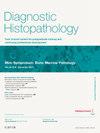Diagnosis of pediatric acute myeloid leukemia and mixed-phenotype acute leukemia
引用次数: 0
Abstract
Pediatric acute myeloid leukemia (AML) represents a group of genetically and clinicopathologically heterogeneous entities, and includes many types that do not occur in adults, presenting unique challenges in clinical practice. Accurate diagnosis and classification impacts therapeutic decisions and relies on an integrated approach that incorporates clinical features, morphologic examination, immunophenotyping, and comprehensive genetic testing. This review covers the clinicopathologic spectrum of pediatric AML, with a focus on age-specific genetic abnormalities and morphologic variants. We present a diagnostic approach to pediatric AML that incorporates the age of presentation together with morphologic and immunophenotypic clues that may suggest an underlying genetic driver, or that should prompt additional testing. In addition to a description of the most common pediatric AML entities (KMT2A-r, RUNX1::RUNX1T1; CBFB::MYH11, and NUP98-r), we detail particular types of AML that are enriched in children. These include acute megakaryoblastic and erythroid leukemias, as well as newly described entities including AML with KAT6A-r, ETS-family fusions (including MNX1::ETV6 and FUS::ERG), UBTF-tandem duplications, CBFB=GDXY, KMT2A-PTD, and TTMV::RARA, among others. Finally, we include a description of myeloid proliferations of Down syndrome and mixed-phenotype acute leukemias. Key differences from adult AML are emphasized, with a focus on the critical interpretive role of the pathologist in integrating bone marrow findings with clinical and molecular data for accurate classification and risk stratification.
小儿急性髓性白血病和混合表型急性白血病的诊断
小儿急性髓性白血病(AML)代表了一组遗传和临床病理异质性的实体,包括许多不发生在成人身上的类型,在临床实践中提出了独特的挑战。准确的诊断和分类影响治疗决策,并依赖于结合临床特征、形态学检查、免疫表型和综合基因检测的综合方法。这篇综述涵盖了儿科AML的临床病理谱,重点是年龄特异性遗传异常和形态变异。我们提出了一种儿科AML的诊断方法,该方法结合了表现年龄以及形态学和免疫表型线索,这些线索可能提示潜在的遗传驱动因素,或者应该提示额外的检测。除了描述最常见的儿科AML实体(KMT2A-r、RUNX1::RUNX1T1、CBFB::MYH11和NUP98-r)外,我们还详细介绍了儿童中丰富的特定类型的AML。这些包括急性巨核母细胞白血病和红系白血病,以及新描述的实体,包括AML与KAT6A-r, ets家族融合(包括MNX1::ETV6和FUS::ERG), ubtf -串联重复,CBFB=GDXY, KMT2A-PTD和TTMV::RARA等。最后,我们包括骨髓增生的唐氏综合症和混合表型急性白血病的描述。强调了与成人AML的主要区别,重点是病理学家在将骨髓发现与临床和分子数据相结合以进行准确分类和风险分层方面的关键解释作用。
本文章由计算机程序翻译,如有差异,请以英文原文为准。
求助全文
约1分钟内获得全文
求助全文
来源期刊

Diagnostic Histopathology
Medicine-Pathology and Forensic Medicine
CiteScore
1.30
自引率
0.00%
发文量
64
期刊介绍:
This monthly review journal aims to provide the practising diagnostic pathologist and trainee pathologist with up-to-date reviews on histopathology and cytology and related technical advances. Each issue contains invited articles on a variety of topics from experts in the field and includes a mini-symposium exploring one subject in greater depth. Articles consist of system-based, disease-based reviews and advances in technology. They update the readers on day-to-day diagnostic work and keep them informed of important new developments. An additional feature is the short section devoted to hypotheses; these have been refereed. There is also a correspondence section.
 求助内容:
求助内容: 应助结果提醒方式:
应助结果提醒方式:


